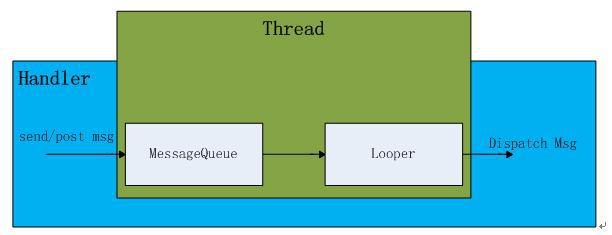-

移动开发
站-
热门城市 全国站>
-
其他省市
-
-

 400-636-0069
400-636-0069
 安安
2017-09-20
来源 :网络
阅读 1057
评论 0
安安
2017-09-20
来源 :网络
阅读 1057
评论 0
摘要:Android编程中的消息机制几乎是面试必问的话题,当然也并不是因为面试,而去学习,更重要的是它在Android的开发中是必不可少的,占着举足轻重的地位,所以弄懂它是很有必要的。下面就来说说最基本的东西。
Android编程中的消息机制几乎是面试必问的话题,当然也并不是因为面试,而去学习,更重要的是它在Android的开发中是必不可少的,占着举足轻重的地位,所以弄懂它是很有必要的。下面就来说说最基本的东西。
Looper
作用:
· 关联起Thread
· 循环取出消息
1、Looper是否可以直接实例化?
Looper构造方法是私有的,其中做了两件事
· 创建一个MessageQueue
· 得到与之对应的Thread
private Looper(boolean quitAllowed) {
mQueue = new MessageQueue(quitAllowed);
mThread = Thread.currentThread();
}
2、一个线程能对应多个Lopper?
不能,一个线程对应一个Looper对象,通过ThreadLocal保证一个线程只有一个Looper与之对应,如果多次调用Looper.prepare();则会抛出运行时异常。
private static void prepare(boolean quitAllowed) {
if (sThreadLocal.get() != null) { // 查看是否有looper与当前线程对应
throw new RuntimeException("Only one Looper may be created per thread");
}
sThreadLocal.set(new Looper(quitAllowed));
}
3、Looper是无限循环,会阻塞吗?
是,当开启一个loop后是一个死循环,从MessageQueue中取出消息,处理消息,但是也有可能退出,在没有消息后退出循环。
public static void loop() {
final Looper me = myLooper();
if (me == null) {
throw new RuntimeException("No Looper; Looper.prepare() wasn't called on this thread.");
}
final MessageQueue queue = me.mQueue;
// 略
for (;;) {
Message msg = queue.next(); // might block
if (msg == null) { // 当没有消息的时候,退出
// No message indicates that the message queue is quitting.
return;
}// 略
msg.target.dispatchMessage(msg);
}
4、可以再次调用Looper.prepareMainLooper吗?
不可以,Looper.prepareMainLooper最终也是调用prepare(),同2.
public static void prepareMainLooper() {
prepare(false); // 创建一个Looper
synchronized (Looper.class) {
if (sMainLooper != null) {
throw new IllegalStateException("The main Looper has already been prepared.");
}
sMainLooper = myLooper();
}
}
5、MainLooper什么时候创建的?
MainLooper是启动Activity创建ActivityThread(并不是一个Thread)时候创建,所以不能多次创建。
public static void main(String[] args) {
// 略
Process.setArgV0("<pre-initialized>");
Looper.prepareMainLooper();
// 略
ActivityThread thread = new ActivityThread();
thread.attach(false);
// 略
if (sMainThreadHandler == null) {
sMainThreadHandler = thread.getHandler();
}
// 略
Looper.loop();
throw new RuntimeException("Main thread loop unexpectedly exited");
}
}
Handler
作用:
· 发送消息到MessageQueue
· 处理消息
1、Handler如何与Looper、MessageQueue关联起来?
我们知道一个Looper对应一个Thread,一个Looper包含一个MessageQueue。当我们创建Handler时就会从当前线程中取出与之对应的Looper,让后在从Looper中取出MessageQueue。
// 1、自动获取public Handler(Callback callback, boolean async) {
// 略
mLooper = Looper.myLooper(); // 取出当前线程中的Looper
if (mLooper == null) {
throw new RuntimeException(
"Can't create handler inside thread that has not called Looper.prepare()");
}
mQueue = mLooper.mQueue; // 取出MessageQueue
mCallback = callback;
mAsynchronous = async;
}// 2、传递一个Looper进来public Handler(Looper looper, Callback callback, boolean async) {
mLooper = looper;
mQueue = looper.mQueue;
mCallback = callback;
mAsynchronous = async;
}
Message
单项链表结构。
作用:
· 数据的载体
1、消息如何复用的?
从全局消息池(链表结构)中
public static Message obtain() {
synchronized (sPoolSync) {
if (sPool != null) {
Message m = sPool;
sPool = m.next;
m.next = null;
m.flags = 0; // clear in-use flag
sPoolSize--;
return m;
}
}
return new Message();
}
2、Message为什么能传递?
Android中想要传递对象要么实现Serializable要么Parcelable,在这里是实现了Parcelable接口。
public final class Message implements Parcelable {
// 略
}
3、如何与Handler关联?
我们知道在消息传机制中Handler充当着“快递员”的角色,那么他又是如何与“货物”--Message发生关系呢?实际上Message有一个成员变量target他的类型正是Handler,
/*package*/ Runnable callback;
public int arg1;
public int arg2;
public Object obj;
/*package*/ Handler target; // 关键点
当我们通过Handler去send一个Message时候最终都会为target赋值为this,即当前的Handler。
private boolean enqueueMessage(MessageQueue queue, Message msg, long uptimeMillis) {
msg.target = this; // 赋值语句
if (mAsynchronous) {
msg.setAsynchronous(true);
}
return queue.enqueueMessage(msg, uptimeMillis);
}
另为如果是通过Message.Obtain(),获取的复用Message也会为其赋值。
多说一句,Handler.obtainMessage()调用的就是Message.Obtain()。
public final Message obtainMessage(){
return Message.obtain(this);
}
总结:
通过一系列的包涵关系,最终Looper、Handler、Message、MessageQueue即发生关联,从而形成一个闭合,开启消息循环。

困惑
最近一直在看这方面的知识,但是能力有限,还是有不少困惑,如果有错误,或你理解下面的问题请联系我fvaryu@qq.com,愿与君交流学习,谢谢
1、Message中的sPool,哪里初始化的?为什么Message.obtain()中不会抛异常?
2、ActivityThread并不是线程,为什么可以创建一个Looper,Main Thread什么时候创建?
3、为什么序列化了的对象就可以传递?与Binder有关?
4、MessageQueue对应的是NativeMessageQueue,具体实现需要学习?
5、Loop.loop(),会退出吗?退出时机是什么?如果会退出,那么主线程同样会退出吗?
以上,关于Android编程的全部内容讲解完毕啦,欢迎大家继续关注!更多关于Android编程的干货请关注职坐标Android编程频道!
 喜欢 | 0
喜欢 | 0
 不喜欢 | 0
不喜欢 | 0
您输入的评论内容中包含违禁敏感词
我知道了

请输入正确的手机号码
请输入正确的验证码
您今天的短信下发次数太多了,明天再试试吧!
我们会在第一时间安排职业规划师联系您!
您也可以联系我们的职业规划师咨询:

版权所有 职坐标-一站式IT培训就业服务领导者 沪ICP备13042190号-4
上海海同信息科技有限公司 Copyright ©2015 www.zhizuobiao.com,All Rights Reserved.
 沪公网安备 31011502005948号
沪公网安备 31011502005948号